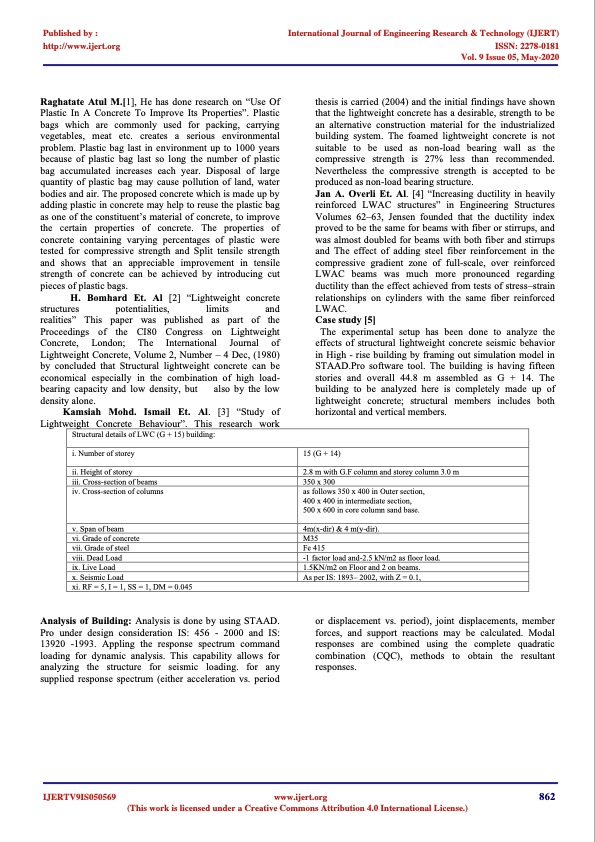
PDF Publication Title:
Text from PDF Page: 002
Published by : http://www.ijert.org Raghatate Atul M.[1], He has done research on “Use Of Plastic In A Concrete To Improve Its Properties”. Plastic bags which are commonly used for packing, carrying vegetables, meat etc. creates a serious environmental problem. Plastic bag last in environment up to 1000 years because of plastic bag last so long the number of plastic bag accumulated increases each year. Disposal of large quantity of plastic bag may cause pollution of land, water bodies and air. The proposed concrete which is made up by adding plastic in concrete may help to reuse the plastic bag as one of the constituent’s material of concrete, to improve the certain properties of concrete. The properties of concrete containing varying percentages of plastic were tested for compressive strength and Split tensile strength and shows that an appreciable improvement in tensile strength of concrete can be achieved by introducing cut pieces of plastic bags. H. Bomhard Et. Al [2] “Lightweight concrete structures potentialities, limits and realities” This paper was published as part of the Proceedings of the CI80 Congress on Lightweight Concrete, London; The International Journal of Lightweight Concrete, Volume 2, Number – 4 Dec, (1980) by concluded that Structural lightweight concrete can be economical especially in the combination of high load- bearing capacity and low density, but also by the low density alone. Kamsiah Mohd. Ismail Et. Al. [3] “Study of Lightweight Concrete Behaviour”. This research work Structural details of LWC (G + 15) building: i. Number of storey ii. Height of storey iii. Cross-section of beams iv. Cross-section of columns v. Span of beam vi. Grade of concrete vii. Grade of steel viii. Dead Load ix. Live Load x. Seismic Load xi. RF = 5, I = 1, SS = 1, DM = 0.045 Analysis of Building: Analysis is done by using STAAD. Pro under design consideration IS: 456 - 2000 and IS: 13920 -1993. Appling the response spectrum command loading for dynamic analysis. This capability allows for analyzing the structure for seismic loading. for any supplied response spectrum (either acceleration vs. period International Journal of Engineering Research & Technology (IJERT) ISSN: 2278-0181 Vol. 9 Issue 05, May-2020 thesis is carried (2004) and the initial findings have shown that the lightweight concrete has a desirable, strength to be an alternative construction material for the industrialized building system. The foamed lightweight concrete is not suitable to be used as non-load bearing wall as the compressive strength is 27% less than recommended. Nevertheless the compressive strength is accepted to be produced as non-load bearing structure. Jan A. Overli Et. Al. [4] “Increasing ductility in heavily reinforced LWAC structures” in Engineering Structures Volumes 62–63, Jensen founded that the ductility index proved to be the same for beams with fiber or stirrups, and was almost doubled for beams with both fiber and stirrups and The effect of adding steel fiber reinforcement in the compressive gradient zone of full-scale, over reinforced LWAC beams was much more pronounced regarding ductility than the effect achieved from tests of stress–strain relationships on cylinders with the same fiber reinforced LWAC. Case study [5] The experimental setup has been done to analyze the effects of structural lightweight concrete seismic behavior in High - rise building by framing out simulation model in STAAD.Pro software tool. The building is having fifteen stories and overall 44.8 m assembled as G + 14. The building to be analyzed here is completely made up of lightweight concrete; structural members includes both horizontal and vertical members. 15(G+14) 2.8 m with G.F column and storey column 3.0 m 350 x 300 as follows 350 x 400 in Outer section, 400 x 400 in intermediate section, 500 x 600 in core column sand base. 4m(x-dir) & 4 m(y-dir). M35 Fe 415 -1 factor load and-2.5 kN/m2 as floor load. 1.5KN/m2 on Floor and 2 on beams. As per IS: 1893– 2002, with Z = 0.1, or displacement vs. period), joint displacements, member forces, and support reactions may be calculated. Modal responses are combined using the complete quadratic combination (CQC), methods to obtain the resultant responses. IJERTV9IS050569 www.ijert.org 862 (This work is licensed under a Creative Commons Attribution 4.0 International License.)PDF Image | Review on the use of High Density Polyethylene (HDPE) in Concrete Mixture

PDF Search Title:
Review on the use of High Density Polyethylene (HDPE) in Concrete MixtureOriginal File Name Searched:
A_Review_on_the_use_of_High_Density_Polyethylene_H.pdfDIY PDF Search: Google It | Yahoo | Bing
Development of a solar powered Electric Ship The Electricship website originally started off as a project to develop a comprehensive renewable, affordable, modular electric ship... More Info
Modular Boat Hull Composite The case for a unsinkable, modular composite hybrid boat hull... More Info
MS Burgenstock Hybrid Electric Catamaran Lake Lucerne Unique shuttle servicing Lucerne to the Burgenstock Resort... More Info
Ground Power Unit GPU Powered by Lithium Ion Batteries The goal of the Ground Power Unit is to provide a readily accessible, modular, ready-to-power solution for remote power... More Info
| CONTACT TEL: 608-238-6001 Email: greg@electricship.com | RSS | AMP |